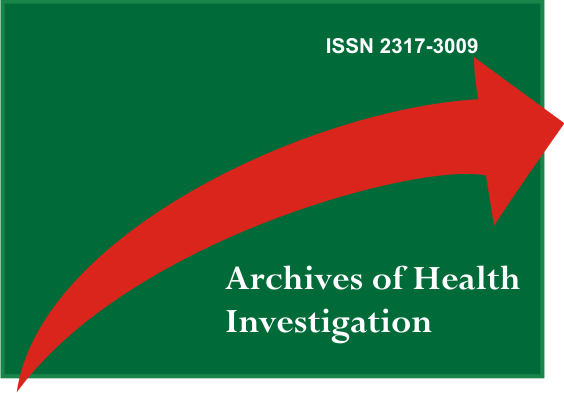Speech-Language Therapy for Treatment of Dysphagia and Dysphonia in Systemic Granulomatous Diseases. Granulomatous Diseases: Dysphagia and Dysphonia Treatments
DOI:
https://doi.org/10.21270/archi.v2i2.132Resumo
The granulomatous lesions are frequently founded in infectious diseases and can involve the larynx and pharynx and can cause varying degrees of dysphonia and dysphagia. There is still no systematic review that analyzes effectiveness of speech therapy in systemic granulomatous diseases. Research strategy: A systematic review was performed according to Cochrane guideline considering the inclusion of RCTs and quasi-RCTs about the effectiveness of speech-language therapy to treat dysphagia and dysphonia symptoms in systemic granulomatous diseases of the larynx and pharynx. Selection criteria: The outcome planned to be measured in this review were: swallowing impairment, frequency of chest infections and voice and swallowing symptoms. Data analysis: We identified 1,140 citations from all electronic databases. After an initial shift we only selected 9 titles to be retrieved in full-text. After full reading, there was no RCT found in this review and therefore, we only described the existing 2 case series studies. Results: There were no randomized controlled trials found in the literature. Therefore, two studies were selected to be included only for narratively analysis as they were case series. Conclusion: There is no evidence from high quality studies about the effectiveness of speech-language therapy in patients with granulomatous diseases of the larynx and pharynx. The investigators could rely in the outcomes suggested in this review to design their own clinical trials.Keywords: Language and Hearing Sciences; Pharynx; Laringe; Deglutition.
Downloads
Referências
Lupi O, Madkan V, Tyring SK. Tropical dermatology: bacterial tropical diseases. Am Acad Dermatol. 2006;54:559-78.
Fortes MRP, Miot HA, Kurokawa CS, Marques MEA, Marques SA. Immunology of paracoccidioidomycosis. An Bras Dermatol. 2011;86(3):516-524.
Fornazieri MA, Yamagutti HY, Moreira JH, Takemoto JE, Navarro PL, Heshiki RE: Manifestações otorrinolaringológicas mais comuns das doenças granulomatosas. Arq Int Otorrinolaringol. 2008;12(3):362-5.
Lim JY, Kim KM, Choi EC, Kim YH, Kim HS, Choi HS. Current clinical propensity of laryngeal tuberculosis: review of 60 cases. Eur Arch Otorhinolaryngol. 2006; 263:838–42.
Sant’Anna GD, Mauri M, Arrarte JL, Camargo H. Laryngeal manifestations of paracoccidioidomycosis (South American Blasromycosis): Arch Otolaryngol Head Neck Surg. 1999;125:1375-8.
Weber SAT, Brasolotto A, Rodrigues L, Marcondes-Machado J, Padovani CR, Carvalho LR, Mendes RP. Dysphonia and laryngeal sequelae in paracoccidioidomycosis patients: a morphological and phoniatric study. Med Mycol. 2006;44:219-225.
Robbins J, Coyle J, Rosenbek J, Roecker E, Wood J: Differentiation of normal and abnormal airway protection during swallowing using the penetration-aspiration scale. Dysphagia. 1999;14:228-32.
Aviv JE. Prospective, randomized outcome study of endoscopy versus modified barium swallow in patients with dysphagia. Laryngoscope. 2000;110:563-74.
Clavé P, Terre R, de Kraa M, Serra M: Approaching oropharyngeal dysphagia. Rev Esp Enferm Dig. 2004; 96:119–31.
Logemann JA. Oropharyngeal dysphagia and nutritional management. Curr Opin Clin Nutr Metab Care. 2007;10(5):611-4.
Lopes Neto JM, Severo LM, Mendes RP, Weber SAT. Sequelae lesions in the larynxes of patients with paracoccidioidomycosis. Braz J Otorhinolaryngol. 2011; 77(1):39-43.
Rosenbek JC, Robbins J, Roecker EB, Coyle JL, Wood JL. A penetration: aspiration scale. Dysphagia. 1996;11:93-8.
Ramsey D, Smithard D, Kalra L. Silent aspiration: what do we know? Dysphagia. 2005; 20:218-25.
Logemann JA: Update on clinical trials in dysphagia. Dysphagia. 2006;21:116–20.
Logemann JA, Gensler G, Robbins J, Lindblad AS, Brandt D, Hind JA et al. A randomized study of three interventions for aspiration of thin liquids in patients with dementia or Parkinson's disease. J Speech Lang Hear Res. 2008;51(1):173-83.
Thibeault SL, Gray SD, Bless DM, Chan RW, Ford CN: Histologic and rheologic characterization of vocal fold scarring. J Voice. 2002;16:96-104.
Ramig LO, Verdolini K. Treatment efficacy: voice disorders. J Speech Lang Hear Res. 1998;41:S101–16.
ASHA. Roles and responsibilities of speech-language pathologists in schools. http://www.asha.org/docs/html/SP2007-00283. Accessed: 1 Sep 2011.
Thomas LB, Stemple JC. Voice therapy: does science support the art? Comm Dis Rev. 2007;1:49 –77.
Yelken K, Guven M, Topak M, Gultekin E, Turan F. Effects of antituberculosis treatment on self assessment, perceptual analysis and acoustic analysis of voice quality in laryngeal tuberculosis patients. J Laryngol Otol. 2008;122:378–382.
Ruas ACN, Rolla VC, Araújo-Melo MH, Moreira JS, Valete-Rosalino CM. Vocal quality of patients treated for laryngeal tuberculosis, before and after speech therapy. J Laryngol Otol. 2010;1-5.
MacKenzie A, Millar A, Wilson JA, Sellars C, Deary IJ. Is voice therapy an effective treatment for dysphonia? A randomised controlled trial. BMJ. 2001;323: 2.
Schwartz SC, Cohen SM, Dailey SH, Rosenfeld RM, Deutsch ES, Gillespie MB et al. Clinical practice guideline: hoarseness (Dysphonia). Otolaryngol Head Neck Surg. 2009;141:S1-S31.
Ulis JM, Yanagisawa E. What’s new in differential diagnosis and treatment of hoarseness? Curr Opin Otolaryngol Head Neck Surg. 2009;17:209–15.
Porras AE, Martin MA, Perez RJ, Avalos SE: Laryngeal tuberculosis. Rev Laryngol Otol Rhinol. 2002;123:47–8.
Sims S, Thakkar KH. Airway involvement and obstruction from granulomas in African-American patients with sarcoidosis. Respir Med. 2007;101(11):2279-83
Pauloski BR. Rehabilitation of dysphagia following head and neck cancer. Phys Med Rehabil Clin N Am. 2008;19:889–928.


